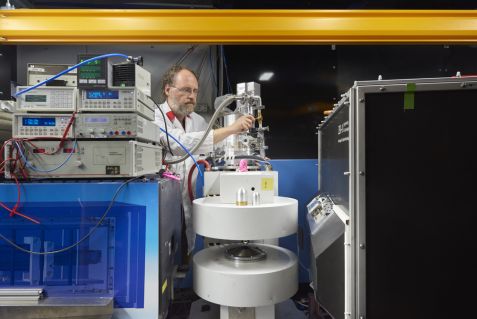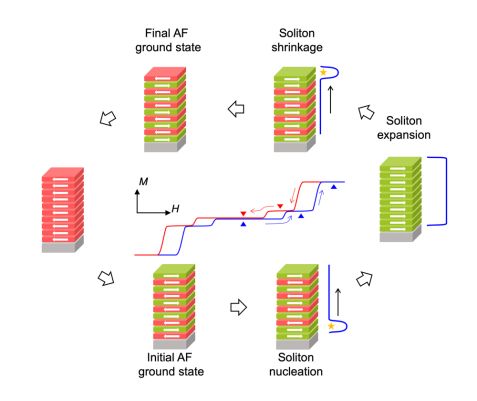MLZ is a cooperation between:
 > Technische Universität München
> Technische Universität München > Helmholtz-Zentrum Hereon
> Helmholtz-Zentrum Hereon
 > Forschungszentrum Jülich
> Forschungszentrum Jülich
MLZ is a member of:
 > LENS
> LENS > ERF-AISBL
> ERF-AISBL
MLZ on social media:

MLZ (eng)
Lichtenbergstr.1
85748 Garching
19.05.2021
Towards 3D storage elements with high data density

The measurements at the Heinz Maier-Leibnitz Zentrum were carried out by the team at the MARIA neutron reflectometer with instrument scientist Dr. Alexandros Koutsioumpas. © W. Schürmann / TUM
Scientists at Jülich, together with their international colleagues, have now shed light on the switching mechanism of an oxide-based synthetic antiferromagnet. They also showed how this material could enable vertical data transfer, thus making it possible to develop three-dimensional storage elements with high data density. The researchers conducted their studies with the help of the neutron reflectometer MARIA, operated by the Jülich Centre for Neutron Science (JCNS) at the Heinz Maier-Leibnitz Zentrum (MLZ) in Garching, along with similar instruments in other European neutron facilities.
Antiferromagnetic oxide materials offer the promise of advances in information technology and nanomedicine. In contrast to ferromagnetic materials, they are not affected by interference from external magnetic fields and could store data more permanently and reliably than is currently possible with magnetic materials. Oxide systems are thus of more interest than metallic ones, because they are easier to switch.
Magnetic states in an antiferromagnet

The image shows the layer-resolved individual steps of the magnetic reversal process in the oxide-based synthetic antiferromagnet under investigation. The corresponding hysteresis curve is shown in the middle. © Forschungszentrum Jülich and University of Science and Technology of China
Unlike a ferromagnet, an antiferromagnet does not have a magnetic field that can be measured externally. Nevertheless, it is not considered to be a completely non-magnetic material. The spins of the electrons, however, are not aligned in parallel as in a ferromagnet, but in opposite directions. The magnetic moments therefore cancel each other out. Some members of the research team already presented their findings on the synthetically produced antiferromagnet now under investigation in a scientific publication in 2017. They showed that the material can be magnetised and reversed in polarity layer by layer by means of an external magnetic field – and therefore can be switched back and forth between different magnetic states in a controlled manner. Ferromagnetic manganate layers with a thickness of just a few nanometres are antiferromagnetically coupled to each other using ultra-thin, insulating titanium oxide layers. The polarisation direction of the spins reverses when transferred from one layer to the other.
Analysing the magnetic switching process with neutrons
The researchers from the JCNS and their colleagues from China, France, Switzerland and Great Britain have now identified the mechanism underlying the switching process. With the help of a polarised neutron reflectometry method, they succeeded in analysing the magnetic configuration of the layer system with microscopic resolution. In doing so, they found that magnetic solitons – boundary regions between two antiferromagnetically ordered zones that are vertically mobile – play an essential role in the process. These soliton waves also make it possible to transport data between the different layers of the system. The results thus indicate a path to the development of three-dimensional storage elements with high data density.
Original text: Angela Wenzik / JCNS
Original publication:
Soliton-Mediated Magnetic Reversal in an All-Oxide-Based Synthetic Antiferromagnetic Superlattice;
Kexuan Zhang, Kirill Zhernenkov, Thomas Saerbeck, Artur Glavic, Lili Qu, Christy J. Kinane, Andrew J. Caruana, Enda Hua, Guanyin Gao, Feng Jin, Binghui Ge, Feng Cheng, Sabine Pütter, Alexandros Koutsioubas, Stefan Mattauch, Thomas Brueckel, Yixi Su, Lingfei Wang, and Wenbin Wu;
ACS Applied Materials & Interfaces Article ASAP, DOI: 10.1021/acsami.1c02506
All-oxide-based synthetic antiferromagnets exhibiting layer-resolved magnetization reversal;
Binbin Chen, Haoran Xu, Chao Ma, Stefan Mattauch, Da Lan, Feng Jin, Zhuang Guo, Siyuan Wan, Pingfan Chen, Guanyin Gao, Feng Chen, Yixi Su, Wenbin Wu;
Science (published 14 July 2017), DOI: 10.1126/science.aak9717
Related News:
Article: “Science: Using Neutrons for Switchable Antiferromagnets”, Forschungszentrum Jülich from 14 July 2017: https://www.fzj.de/SharedDocs/Pressemitteilungen/UK/EN/notifications/2017-07-13-science-antiferromagnet.html;jsessionid=D99580CC63FD7D2E23CD4DAC9D3CB5E6
MLZ is a cooperation between:
 > Technische Universität München
> Technische Universität München > Helmholtz-Zentrum Hereon
> Helmholtz-Zentrum Hereon
 > Forschungszentrum Jülich
> Forschungszentrum Jülich
MLZ is a member of:
 > LENS
> LENS > ERF-AISBL
> ERF-AISBL
MLZ on social media:



